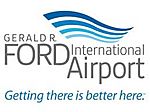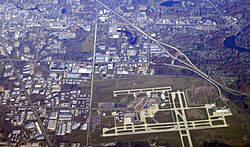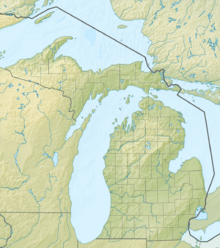Gerald R. Ford International Airport facts for kids
Quick facts for kids
Gerald R. Ford International Airport
|
|||||||||||||||||||
|---|---|---|---|---|---|---|---|---|---|---|---|---|---|---|---|---|---|---|---|
 |
|||||||||||||||||||

Gerald R. Ford International Airport
|
|||||||||||||||||||
| Summary | |||||||||||||||||||
| Airport type | Public | ||||||||||||||||||
| Owner | Gerald R. Ford International Airport Authority & Kent County | ||||||||||||||||||
| Operator | Gerald R. Ford International Airport Authority | ||||||||||||||||||
| Serves | Grand Rapids, Michigan | ||||||||||||||||||
| Location | Cascade Charter Township, MI, US | ||||||||||||||||||
| Focus city for | Allegiant Air | ||||||||||||||||||
| Elevation AMSL | 794 ft / 242 m | ||||||||||||||||||
| Coordinates | 42°52′51″N 85°31′22″W / 42.88083°N 85.52278°W | ||||||||||||||||||
| Map | |||||||||||||||||||
| Runway | |||||||||||||||||||
|
|||||||||||||||||||
| Statistics (2019) | |||||||||||||||||||
|
|||||||||||||||||||
|
Sources GRR and FAA
|
|||||||||||||||||||
Gerald R. Ford International Airport (IATA: GRR, ICAO: KGRR, FAA LID: GRR) is a commercial airport in Cascade Township approximately 13 miles (21 km) southeast of Grand Rapids, Michigan. The facility is owned by the Kent County Board of Commissioners and managed by an independent authority. The Federal Aviation Administration (FAA) National Plan of Integrated Airport Systems for 2017–2021 categorized it as a small hub primary commercial service facility.
The facility opened as the Kent County Airport and later became Kent County International Airport; in December 1999 the airport was renamed for Gerald R. Ford, the 40th Vice President and the 38th President of the United States. Ford represented the Grand Rapids area in the United States House of Representatives from 1949 to 1973.
The airport is the largest commercial airport in the West Michigan region and is the second-largest airport in Michigan after Detroit Metropolitan Airport. GRR covers 3,127 acres (1,265 ha).
The airport currently has flights to 34 domestic airports.
Contents
History
Grand Rapids' first airport broke ground in November 1919, four miles (6.4 km) south of downtown. This was eight years after the area witnessed its first landing, a Wright biplane at Comstock Park State Fairgrounds on September 10, 1911. The airport was operated by the Kent County Board of Supervisors.
The first scheduled air service in the United States was between Grand Rapids and Dearborn on a Ford-Stout monoplane named Miss Grand Rapids, which started July 26, 1926.
In 1938–39 the Works Progress Administration made improvements including new runways and runway widening, fencing, sodding, lighting, remodeling the administration building and construction of a new restaurant.
Circa 1940 the airport extended between 32nd and 36th Streets, from Jefferson Avenue east to the railroad; the west end was soon expanded south to just north of Himes Street and in the 1950s runway 18/36 was extended to 5700’ and reached south to 44th Street.
In 1959, the county began construction on the present airport in Cascade Township, several miles east of the first. The new airport opened November 23, 1963, and was dedicated June 6, 1964; it had a 6,600-foot (2,000 m) runway designated 8/26 and a 3,400-foot (1,000 m) designated 18/36. The first scheduled jet was a United Airlines Boeing 737-200 on April 28, 1968, from Chicago O'Hare. The aircraft, N9003U, was named 'City of Grand Rapids'. In 1968, the only scheduled non-stops beyond Michigan were to Chicago and Green Bay.
On January 27, 1977, the Board of Commissioners renamed Kent County Airport as Kent County International Airport with the opening of a U.S. Customs Service Office in the main terminal building.
In 1997, the board added the 8,500-foot (2,600 m) runway 17/35 to allow continued operations during a $32 million reconstruction of runway 8R/26L, completed in 2001. It completed a passenger terminal renovation in 2000 at a cost of approximately $50 million.
In 2004 the airport served more than 2 million passengers for the first time in a year. In 2010, the airport broke the 2004 record with almost 2.2 million passengers, as increase of over 23% from 2009.
On January 2, 2007, a U.S. Air Force jet carried the remains of former president Gerald Ford to his namesake airport as part of funeral services culminating in burial at his presidential museum in Grand Rapids the next day.
From April 2010 through October 2011, the airport was a focus city for Allegiant Air.
Air Canada operated the airport's only international flights to Toronto Pearson International Airport from July 2008 until September 2013. It was the airline's second attempt at service between the two markets.
Delta Air Lines operates Boeing 757-200s seasonally between Grand Rapids and Detroit during the summer, making it the largest aircraft to serve GRR.
Allegiant Air announced in mid-January 2019 that they would be making the airport one of Allegiant's 16 focus cities once again. After dropping GRR as a focus city in 2011, Allegiant is upgrading GRR again to a focus city adding Nashville, Tennessee, and Savannah-Hilton Head, Georgia as new routes.
Facilities
Gerald R. Ford International Airport has two parallel east–west runways and one north–south runway. Along with cargo and general aviation facilities, the airport has a passenger terminal with two concourses: A has seven gates and B has eight. Runways 8R/26L and runway 17/35 have ILS. The airport also has a 5,000-foot (1,500 m) general aviation runway north of the main 8R/26L runway.
In September 2017, the airport celebrated the opening of phase one of their Gateway Transformation, a 59,000 square foot addition onto the passenger terminal facility that included a consolidated passenger security screening checkpoint, a new Marketplace with expanded retail and food & beverage offerings, new business centers and lounges, and much more. Concourse A's tenants are Allegiant Air, Delta Air Lines and Frontier Airlines. American Airlines, Southwest Airlines and United Airlines occupy Concourse B. All gates have climate-controlled jetways.
When new baggage screening regulations were introduced by the Transportation Security Administration in 2002, the airport was the first in the nation to conduct trials on the new screening machines. The baggage processing areas were too small for the machines so they were placed in the passenger lobby.
Airlines and destinations
Passenger
Source:
| Destinations map |
|---|
Cargo
Source: Flight Aware
| Airlines | Destinations |
|---|---|
| FedEx Express | Indianapolis, Memphis, Boston |
| FedEx Feeder | Pellston, Sault Ste. Marie, Traverse City |
The airport handled 91,396,017 pounds (41,456,536 kg) of air freight in 2019.
Statistics
Top domestic destinations
| Rank | City | Passengers | Carriers |
|---|---|---|---|
| 1 | Chicago–O’Hare, Illinois | 125,000 | American, United |
| 2 | Atlanta, Georgia | 110,000 | Delta |
| 3 | Detroit, Michigan | 89,000 | Delta |
| 4 | Denver, Colorado | 80,000 | Frontier, Southwest, United |
| 5 | Minneapolis/St. Paul, Minnesota | 72,000 | Delta |
| 6 | Chicago–Midway, Illinois | 64,000 | Southwest |
| 7 | Dallas/Fort Worth, Texas | 54,000 | American |
| 8 | Charlotte, North Carolina | 48,000 | American |
| 9 | St. Petersburg/Clearwater, Florida | 42,000 | Allegiant |
| 10 | Orlando/Sanford, Florida | 42,000 | Allegiant |
| Rank | Airline | Passengers | Share |
|---|---|---|---|
| 2 | Allegiant Air | 413,000 | 20.22% |
| 1 | Delta Airlines | 375,000 | 18.36% |
| 3 | Southwest Airlines | 277,000 | 13.54% |
| 4 | SkyWest | 182,000 | 8.93% |
| 5 | PSA Airlines | 134,000 | 6.54% |
Annual traffic
| Year | Passengers | Year | Passengers |
|---|---|---|---|
| 2003 | 1,976,833 | 2012 | 2,134,956 |
| 2004 | 2,150,125 | 2013 | 2,237,979 |
| 2005 | 2,090,505 | 2014 | 2,335,105 |
| 2006 | 2,015,846 | 2015 | 2,550,193 |
| 2007 | 1,990,896 | 2016 | 2,653,630 |
| 2008 | 1,809,445 | 2017 | 2,811,622 |
| 2009 | 1,771,465 | 2018 | 3,263,234 |
| 2010 | 2,185,924 | 2019 | 3,587,767 |
| 2011 | 2,275,332 | 2020 | — |
Ground transportation
The airport is at the intersection of 44th Street and Patterson Avenue. It abuts I-96 on the east, M-6 on the south, M-37 on the west, and M-11 on the north.
Metro Cab and Metro Cars provides taxi and luxury sedan service and the airport is served by Avis, Budget, Enterprise, Hertz, and National/Alamo rental car companies on-site.
Rapid route 17, Woodland/Airport, travels between the airport and Woodland Mall (Kentwood Station) on weekdays between 6:30 a.m. and 10:30 p.m. From Woodland Mall, passengers can continue on to downtown or parts of the east side of Grand Rapids via routes 5 and 6, or across town to Grandville and Wyoming on routes 24, 28, and 44.
Aircraft spotting
The airport has two aircraft spotter locations. There is an observation deck located on the mezzanine level of the passenger terminal building, which gives a relatively unobstructed view of the ramp area and runway 8R and 26L.
An outdoor viewing area on Kraft Avenue north of 52nd Street has picnic tables, litter barrels, along with a pavilion with a woman's and men's restoom. Radio station 1650 AM broadcasts transmissions by air traffic controllers, pilots, and GFIA operations and ground crew staff. The viewing area is open year-round daily from dawn to dusk.
Planned development
In 2013 the airport began building a natural treatment system to improve stormwater management practices and safeguard the waters of the Thornapple River. The new, innovative system will include a biological treatment system that will improve collection of stormwater runoff and naturally remove sediments and pollutants before sending the water to the Thornapple River, which flows just east of the airfield.
The airport eliminated the two separate security checkpoints in each concourse and created one consolidated checkpoint in the grand hall area to help traffic flow much faster and to be prepared for future growth. In addition, the grand hall area and the entrance area to the airport was renovated with more shopping and dining options. Work began in late 2015 and completed in June 2017. Concourse A and B were recently refurbished and completed in early 2015.
The airport began construction of a roof over the parking deck in March 2015 to increase close-in, covered, long-term parking. The roof covers most of the fourth floor, though some spaces on the fourth and third floors remain uncovered due to airfield sight-line requirements for the FAA control tower. The garage roof was completed in November 2015 and will allow use of the fourth floor spaces during heavy snow.
In 2016, the airport partnered with the Cascade Community Foundation on plans to renovate the current outdoor viewing area to make it a larger, more inviting place for people to relax. The renovated park opened in May 2017.
In November 2018 the airport began the phase II of the Gateway Transformation Project, reconstructing the baggage claim, check-in, and front of house areas, and have completed the apron reconstruction adding new pavement to the apron and taxiway areas.
In late August 2019, the airport made an announcement about its next focus, Project Elevate. This phase of airport development, consisting of three major projects, includes a $90 million expansion and extension of Concourse A to encompass 8 more gates, a $50 million relocation and construction of a new air traffic control tower as well as a $25 million federal inspection station to facilitate departures and arrivals of direct international flights.
- FAA Airport Diagram (PDF), effective 15 December 2011
- Resources for this airport:
- AirNav airport information for KGRR
- ASN accident history for GRR
- FlightAware airport information and live flight tracker
- NOAA/NWS latest weather observations
- SkyVector aeronautical chart for KGRR
- FAA current GRR delay information
See also
 In Spanish: Aeropuerto Internacional Gerald R. Ford para niños
In Spanish: Aeropuerto Internacional Gerald R. Ford para niños



